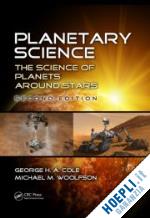Since the publication of the popular first edition, stellar and planetary scientists have produced numerous new observations, theories, and interpretations, including the "demotion" of our former ninth planet Pluto as a dwarf planet. Covering all of these new discoveries, Planetary Science: The Science of Planets around Stars, Second Edition explains the science associated with the planets, the stars they orbit, and the interactions between them. It examines the formation, evolution, and death of stars and the properties of the Sun that influence the planets of the Solar System. Along with more problems, this second edition adds new material and improves some analytical treatments. The book consists of two main components. For students unfamiliar with stellar properties or the overall structure of the Solar System, the first part gives a general picture of the system as a whole and the interrelationships of the bodies within it. It presents an overview of the nature of stars and the Solar System as well as important results obtained by scientific analysis. The second component is a set of 43 appendices describing the majority of the underlying science required to explain the main features of the Solar System. These appendices cover a variety of specialized topics, from mineralogy to the mechanical interactions of radiation and matter. End-of-chapter problems give students a quantitative understanding of stellar and solar system phenomena. The text shows how useful estimates of various quantities can be made even when characteristics of the system are not known with any precision. While the problems can be completed with a hand calculator, students are encouraged to use the Fortran computer programs provided on the book’s CRC Press web page. Avoiding excessive details, this textbook offers a comprehensive account of stellar and planetary topics. It is suitable for students from a range of disciplines, including astronomy, geology, and earth sciences. The book provides students with an understanding of the nature of the Solar System and the influences that govern its behavior, helping them develop an appreciation of the forces that can influence our planet in the future.











